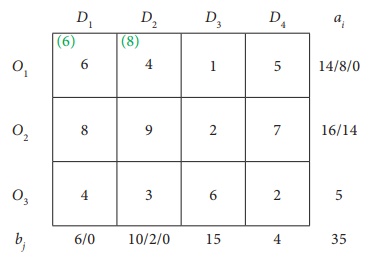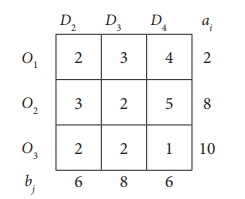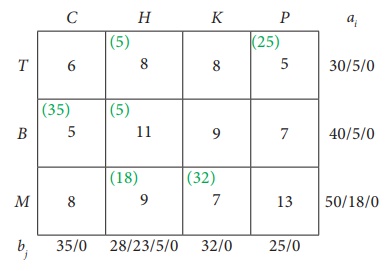Solved Example Problems | Transportation Problem | Operations Research - Methods of finding initial Basic Feasible Solutions | 12th Business Maths and Statistics : Chapter 10 : Operations Research
Chapter: 12th Business Maths and Statistics : Chapter 10 : Operations Research
Methods of finding initial Basic Feasible Solutions
Methods
of finding initial Basic Feasible Solutions
There are several
methods available to obtain an initial basic feasible solution of a
transportation problem. We discuss here only the following three. For finding
the initial basic feasible solution total supply must be equal to total demand.

Method:1North-West Corner Rule (NWC)
It is a simple method to
obtain an initial basic feasible solution. Various steps involved in this
method are summarized below.
Step 1: Choose the cell in the
north- west corner of the transportation Table10.1 and allocate as much
as possible in this cell so that either the capacity of first row (supply)is
exhausted or the destination requirement of the first column(demand) is
exhausted. (i.e) x11 = min(a1,b1)
Step 2: If the demand is
exhausted (b1 < a1), move
one cell right horizontally tothe second column and allocate as much as
possible.(i.e) x12= min (a1 ŌĆōx11,
b2)
If the supply is
exhausted (b1 > a1), move one cell down
vertically to the second row and allocateas much as possible.(i.e)x21
= min (a2,b1 ŌĆō x11)
If both supply and
demand are exhausted move one cell diagonally and allocate as much as possible.
Step 3: Continue the above
procedure until all the allocations are made
Example
10.1
Obtain the initial
solution for the following problem

Solution:
Here total supply =
5+8+7+14=34, Total demand = 7+9+18=34
(i.e) Total supply
=Total demandŌł┤The given problem is balanced transportation problem.
Ōł┤
we can findan initial basic feasible solution to the given problem.
From the above table we
can choose the cell in the North West Corner. Here the cell is (1,A)
Allocate as much as
possible in this cell so that either the capacity of first row is exhausted or
the destination requirement of the first column is exhausted.
i.e. x11 =
min (5,7) = 5

Reduced transportation
table is

Now the cell in the North west corner is (2, A)
Allocate as much as
possible in the first cell so that either the capacity of second row is
exhausted or the destination requirement of the first column is exhausted.
i.e. x12 =
min (2,8) = 2

Reduced transportation
table is

Here north west corner
cell is (2,B) Allocate as much as possible in the first cell so that either the
capacity of second row is exhausted or the destination requirement of the
second column is exhausted.
i.e. x22 =
min (6,9) = 6

Reduced transportation
table is

Here north west corner
cell is (3,B).
Allocate as much as
possible in the first cell so that either the capacity of third row is
exhausted or the destination requirement of the second column is exhausted.
i.e. x32 =
min (7,3) = 3

Reduced transportation
table is

Here north west corner
cell is (3,C) Allocate as much as possible in the first cell so that either the
capacity of third row is exhausted or the destination requirement of the third
column is exhausted.
i.e. x33 =
min (4,18) = 4

Reduced transportation
table and final allocation is x44 = 14

Thus we have the
following allocations

Transportation schedule
: 1ŌåÆ A, 2ŌåÆA, 2ŌåÆB, 3ŌåÆB, 3ŌåÆC, 4ŌåÆC
The total transportation
cost.
= (5 ├Ś 2) + (2 ├Ś 3) +(6
├Ś 3)+(3 ├Ś 4)+(4 ├Ś 7) + (14 ├Ś 2)
= Rs.102
Example
10.2
Determine an initial
basic feasible solution to the following transportation problem using North
West corner rule.

Here Oi and Dj
represent ith origin and jth destination.
Solution:
Given transportation
table is

Total Availability =
Total Requirement
Ōł┤
The given problem is balanced transportation problem.
Hence there exists a
feasible solution to the given problem.
First allocation:

Second allocation:

Third Allocation:

Fourth Allocation:

Fifth allocation:

Final allocation:

Transportation schedule
: O1ŌåÆ D1, O1ŌåÆD2, O2ŌåÆD2,
O2ŌåÆD3, O3ŌåÆD3, O3ŌåÆD3.
The transportation cost
= (6 ├Ś 6)+(8 ├Ś 4)+(2 ├Ś
9)+(14 ├Ś 2)+(1 ├Ś 6)+(4 ├Ś 2) =Rs.128
Method:2 Least Cost Method (LCM)
The least cost method is
more economical than north-west corner rule,since it starts with a lower
beginning cost. Various steps involved in this method are summarized as under.
Step 1: Find the cell with the
least(minimum) cost in the transportation table.
Step 2: Allocate the maximum
feasible quantity to this cell.
Step:3: Eliminate the row or
column where an allocation is made.
Step:4: Repeat the above steps
for the reduced transportation table until all the allocations are made.
Example
10.3
Obtain an initial basic
feasible solution to the following transportation problem using least cost
method.

Here Oi and Dj
denote ith origin and jth destination respectively.
Solution:
Total Supply = Total
Demand = 24
Ōł┤
The given problem is a balanced transportation problem.
Hence there exists a
feasible solution to the given problem.
Given Transportation
Problem is:

The least cost is 1
corresponds to the cells (O1, D1) and (O3, D4)
Take the Cell (O1,
D1) arbitrarily.
Allocatemin (6,4) = 4
units to this cell.

The reduced table is

The least cost
corresponds to the cell (O3, D4). Allocate min (10,6) = 6
units to this cell.

The reduced table is

The least costis 2
corresponds to the cells (O1, D2), (O2, D3),
(O3, D2), (O3, D3)
Allocate min (2,6) = 2
units to this cell.

The reduced table is

The least cost is 2
corresponds to the cells (O2, D3), (O3, D2),
(O3, D3)
Allocate min ( 8,8) = 8
units to this cell.

The reduced table is

Here allocate 4 units in
the cell (O3, D2)

Thus we have the following
allocations:

Transportation schedule
:
O1ŌåÆ D1, O1ŌåÆD2, O2ŌåÆD3,
O3ŌåÆD2, O3ŌåÆD4
Total transportation
cost
= (4├Ś1)+ (2├Ś2)+(8├Ś2)+(4├Ś2)+(6├Ś1)
= 4+4+16+8+6
=Rs. 38.
Example
10.4
Determine how much
quantity should be stepped from factory to various destinations for the
following transportation problem using the least cost method

Cost are expressed in
terms of rupees per unit shipped.
Solution:
Total Capacity = Total
Demand
Ōł┤
The given problem is balanced transportation problem.
Hence there exists a
feasible solution to the given problem.
Given Transportation
Problem is

First
Allocation:

Second Allocation:

Third Allocation:

Fourth Allocation:

Fifth Allocation:

Sixth Allocation:

Transportation schedule
:
TŌåÆ H, TŌåÆP, BŌåÆC, BŌåÆH,
MŌåÆH, MŌåÆK
The total Transportation
cost = ( 5├Ś8) + (25├Ś5)+ (35├Ś5) + (5├Ś11)+ (18├Ś9) + (32├Ś7)
= 40+125+175+55+162+224
= Ōé╣ 781
Method:3 VogelŌĆÖs Approximation Method(VAM)
VogelŌĆÖs approximation
method yields an initial basic feasible solution which is very close to the
optimum solution.Various steps involved in this method are summarized as under
Step 1: Calculate the penalties
for each row and each column. Here penalty means the difference between
the two successive least cost in a row and in a column .
Step 2: Select the row or
column with the largest penalty.
Step 3: In the selected row or
column, allocate the maximum feasible quantity to the cell with the
minimum cost.
Step 4: Eliminate the row or
column where all the allocations are made.
Step 5: Write the reduced
transportation table and repeat the steps 1 to 4.
Step 6: Repeat the procedure
until all the allocations are made.
Example
10.5
Find the initial basic
feasible solution for the following transportation problem by VAM

Solution:
Here Ōłæai = Ōłæbj
= 950
(i.e) Total Availability
=Total Requirement
Ōł┤The
given problem is balanced transportation problem.
Hence there exists a
feasible solution to the given problem.
First let us find the
difference (penalty) between the first two smallest costs in each row and
column and write them in brackets against the respective rows and columns

Choose the largest
difference. Here the difference is 5 which corresponds to column D1
and D2. Choose either D1 or D2 arbitrarily.
Here we take the column D1 . In this column choose the least cost.
Here the least cost corresponds to (S1, D1) . Allocate
min (250, 200) = 200units to this Cell.
The reduced
transportation table is

Choose the largest
difference. Here the difference is 5 which corresponds to column D2.
In this column choose the least cost. Here the least cost corresponds to (S1,
D2) . Allocate min(50,175) = 50 units to this Cell.
The reduced
transportation table is

Choose the largest
difference. Here the difference is 6 which corresponds to column D2.
In this column choose the least cost. Here the least cost corresponds to (S2,
D2) .
Allocate min(300,175) =
175 units to this cell.
The reduced
transportation table is

Choose the largest
difference. Here the difference is 4 corresponds to row S2. In this
row choose the least cost. Here the least cost corresponds to (S2, D4)
. Allocate min(125,250) = 125 units to this Cell.
The reduced transportation table is

The Allocation is

Thus we have the
following allocations:

Transportation schedule :
S1ŌåÆ D1,
S1ŌåÆD2, S2ŌåÆD2, S2ŌåÆD4,
S3ŌåÆD3, S3ŌåÆD4
This initial
transportation cost
= (200 ├Ś 11) + (50 ├Ś13)
+ (175 ├Ś 18) + (125 ├Ś10) + (275 ├Ś13) + (125 ├Ś10)
= Ōé╣ 12,075
Example
10.5
Obtain an initial basic
feasible solution to the following transportation problem using VogelŌĆÖs
approximation method.

Solution:
Here Ōłæai = Ōłæbj
= 80 (i.e) Total Availability =Total Requirement
Ōł┤The
given problem is balanced transportation problem.
Hence there exists a
feasible solution to the given problem.
First Allocation:

Second Allocation:

Third Allocation:

Fourth Allocation:

Fifth Allocation:

Sixth Allocation:

Thus we have the
following allocations:

Transportation schedule
:
AŌåÆ I, AŌåÆII, AŌåÆIII, AŌåÆIV,
BŌåÆI, CŌåÆIV, DŌåÆII
Total transportation
cost:
= ( 6 ├Ś 5)+ ( 6 + 1)+ (17
├Ś 3)+ ( 5 ├Ś 3)+ (15 ├Ś 3) + (12 ├Ś 3)+ (1 9 ├Ś1)
= 30 + 6 + 51 + 15 + 45 +
36 + 19
= Ōé╣ 202
Related Topics